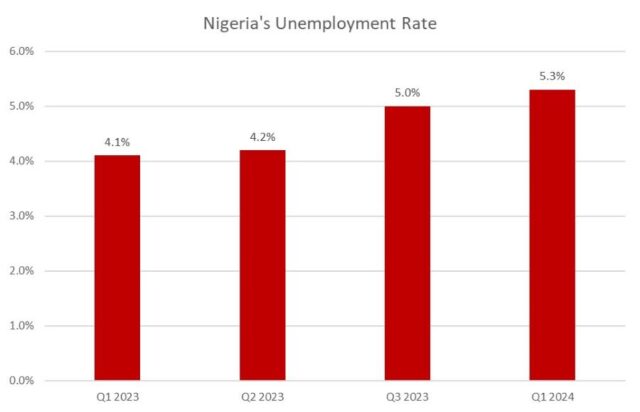…The labour force participation rate fell from 79.5% to 77.3%, suggesting a decline in the number of people actively seeking work.
…Weakening Employment: The employment-to-population ratio decreased from 75.6% to 73.2%, indicating a decline in the proportion of the working-age population employed.
…Improved Unemployment and Underemployment: The combined unemployment and time-related underemployment rate decreased from 17.3% to 15.3%, suggesting a slight improvement in labour market conditions.
WED SEPT 25 2024-theGBJournal| Nigeria, despite being Africa’s largest economy, continues to grapple with a persistent unemployment problem.
The Unemployment rate increased to 5.3% in the first quarter of 2024 from 5.0% in Q3 2023, according to latest data published by Nigeria’s National Bureau of Statistics (NBS).
The country’s unemployment rate, while fluctuating, remains persistently high, impacting both youth and adults.
This is exacerbated by factors such as limited job opportunities, inadequate skills development, and economic instability. While there was a slight improvement in the overall unemployment rate and time-related underemployment, the labour force participation rate and employment-to-population ratio declined, indicating a weakening labour market.
Key Findings
•Decreasing Labour Force Participation: The labour force participation rate fell from 79.5% to 77.3%, suggesting a decline in the number of people actively seeking work.
•Weakening Employment: The employment-to-population ratio decreased from 75.6% to 73.2%, indicating a decline in the proportion of the working-age population employed.
•Improved Unemployment and Underemployment: The combined unemployment and time-related underemployment rate decreased from 17.3% to 15.3%, suggesting a slight improvement in labour market conditions.
•Rising Wage Employment: The proportion of workers in wage employment increased from 12.7% to 16.0%, indicating a shift towards wage-based work.
•Educational Disparities: The unemployment rate among persons with post-secondary education remained higher than the overall average, at 9.0%.
•Youth Unemployment: While youth unemployment declined slightly, it remained above the overall average at 8.4%.
•Urban-Rural Divide: The unemployment rate in urban areas remained unchanged, while time-related underemployment decreased in Q1 2024.
•Subsistence Agriculture: 4.5% of the working-age population was engaged in subsistence agriculture, indicating a significant portion of the population reliant on traditional agricultural practices.
•Rising NEET Rate: The NEET rate increased, suggesting a growing number of young people not in education, employment, or training.
”The weakening Nigerian labour market is evidenced by key metrics such as the declining labour force participation rate, which dropped from 79.5% to 77.3%, and the employment-to-population ratio, which fell from 75.6% to 73.2%,” says analysts at Comercio Partners Research.
”These indicators show that fewer Nigerians are either working or actively seeking employment, signalling a broader slowdown in the labour market.”
Since the last report in Q3 2023, international firms have been exiting Nigeria due to an increasingly challenging macroeconomic environment. Key factors include the removal of fuel subsidies, resulting in higher energy costs, and foreign exchange volatility, which has increased the cost of business operations.
These challenges have eroded profit margins for firms, causing downsizing or complete exits from the market, thereby exacerbating unemployment rates.
The limited availability of formal employment has driven a significant portion of the population into informal work or unemployment. Furthermore, individuals with post-secondary education are facing disproportionately high unemployment rates of 9%. This suggests that educational qualifications alone are not sufficient to secure employment in the current economic climate.
Youth unemployment remains a critical issue, with a rate of 8.4%, still higher than the general population’s average. This highlights the difficulty young Nigerians face in securing jobs, necessitating targeted policies to improve youth employment prospects.
The educational disparities in unemployment rates highlight the need for targeted interventions to improve job prospects for individuals with lower levels of education. The persistence of youth unemployment is a significant challenge, requiring policies to address the barriers faced by young people in entering the labour market.
Nigeria’s labour market is undergoing significant strain due to macroeconomic pressures, high unemployment rates among educated individuals, and persistent youth unemployment.
These trends call for urgent policy interventions to create sustainable job opportunities, especially for younger and less-educated populations.-Analysis is provided by Comercio Partners Research.
X-@theGBJournal|Facebook-the Government and Business Journal|email:gbj@govbusinessjournal.com|govandbusinessj@gmail.com










